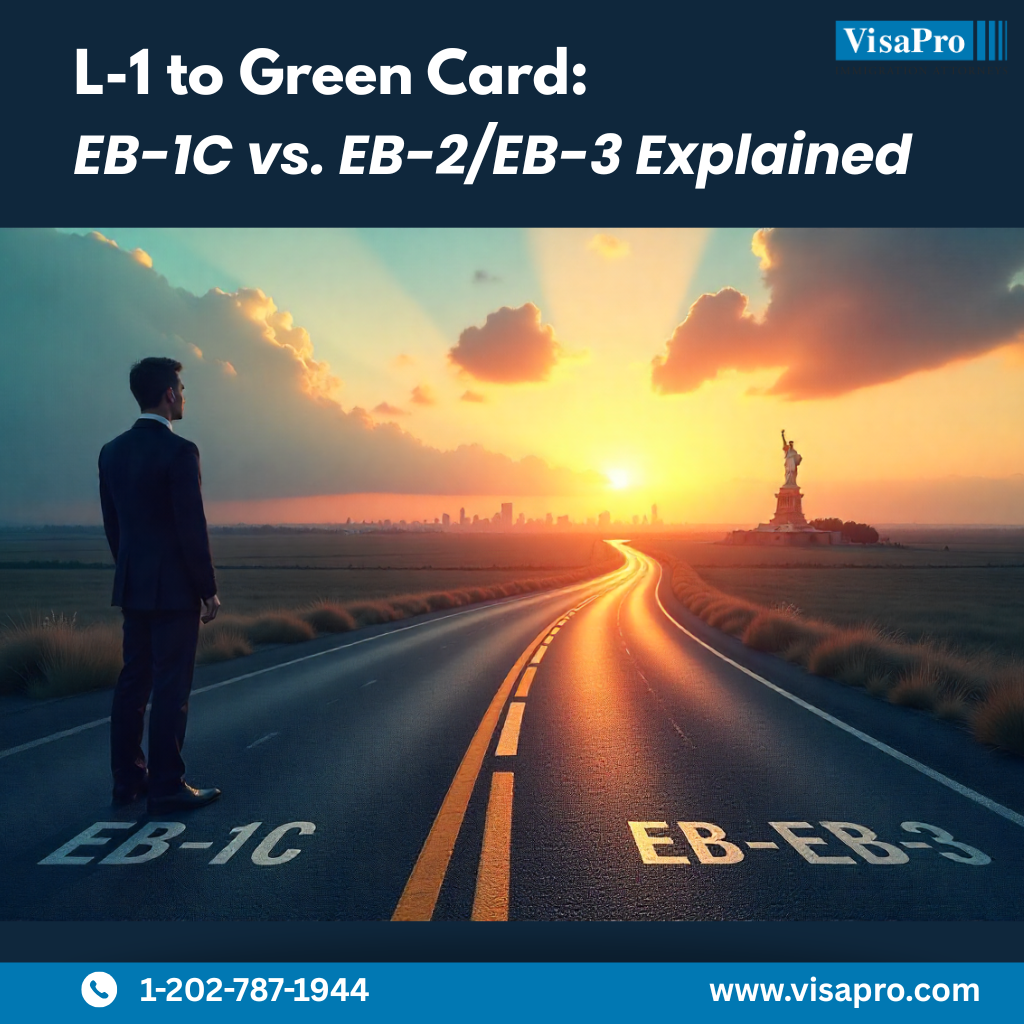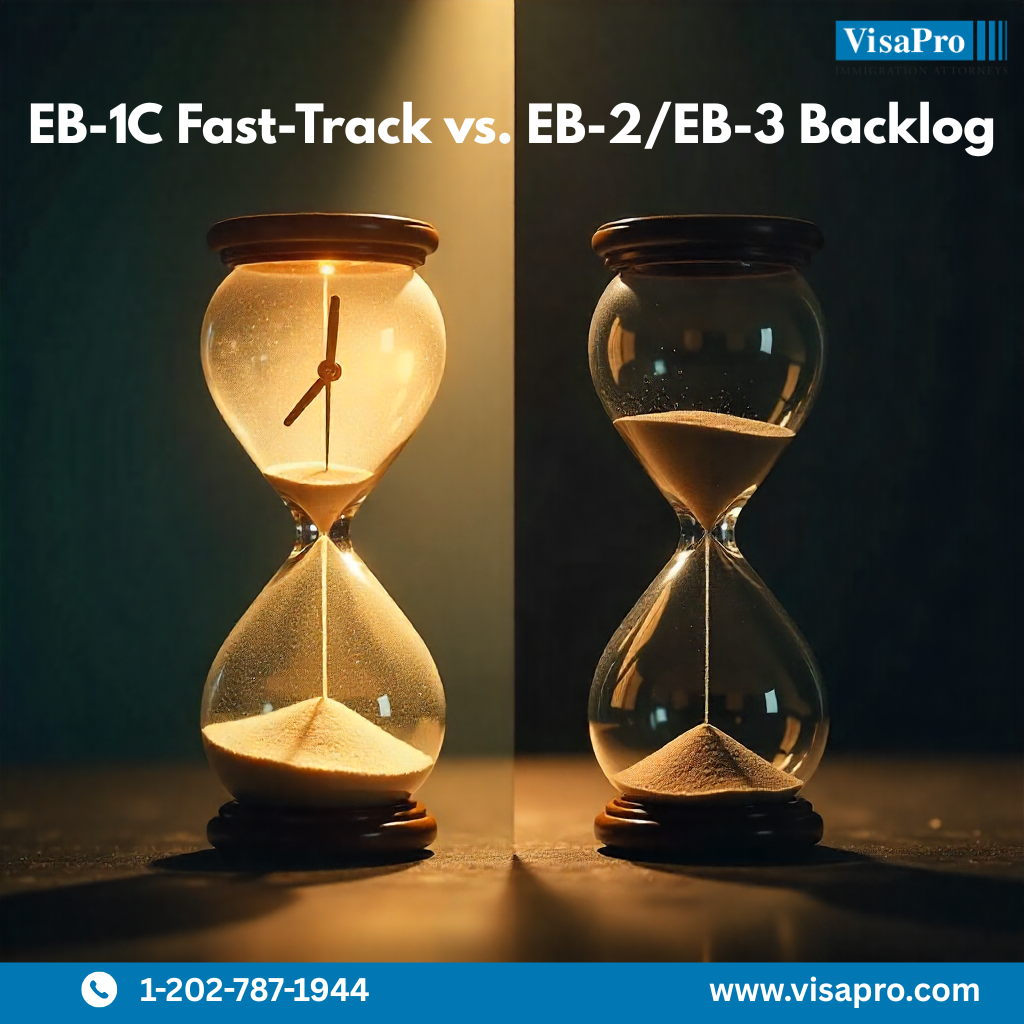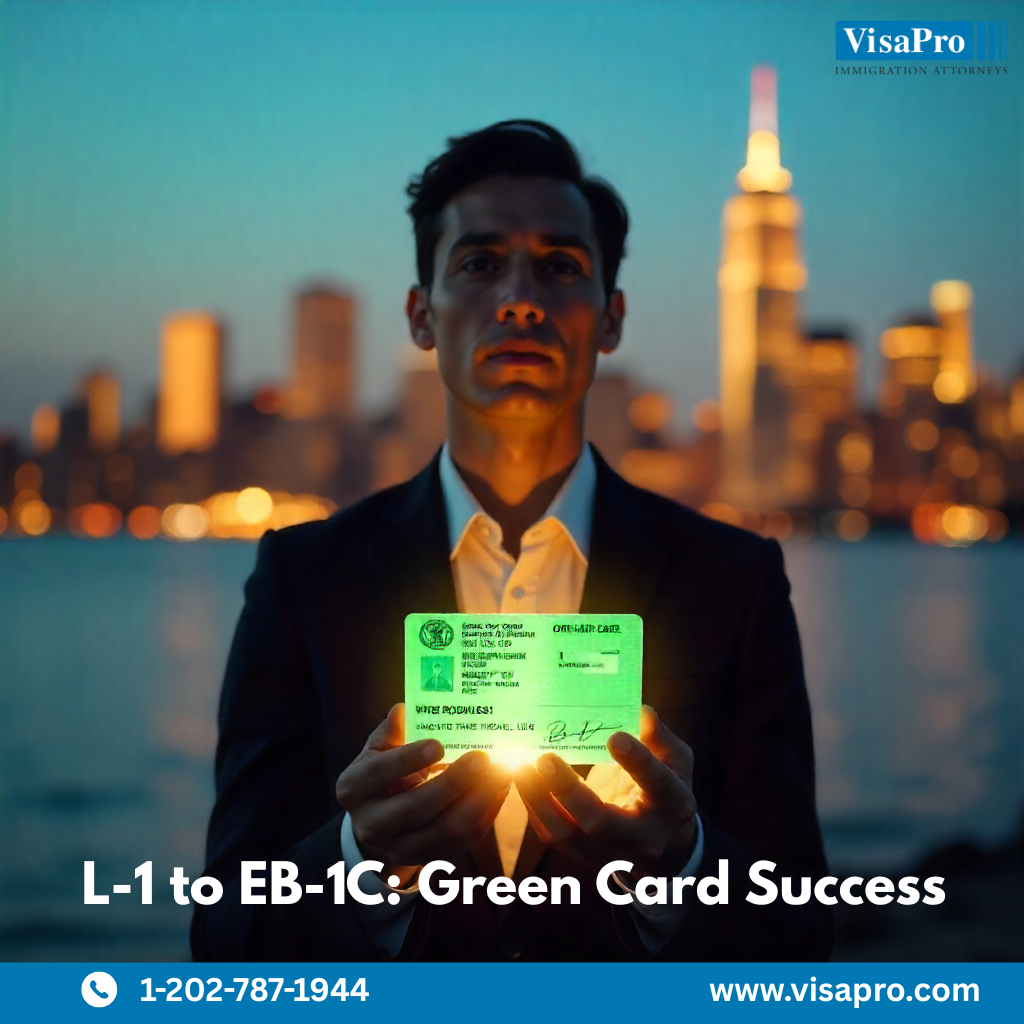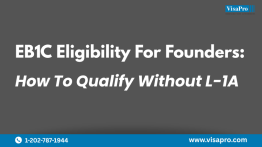Quick Summary:
If you’re currently on an L-1 visa and wondering how to secure permanent residency, you’re not alone. Many international professionals in your position face uncertainty about timelines, sponsorship, and the right path forward. This guide walks you through how to pursue an EB-2 or EB-3 Green Card from L-1 status, the steps involved, alternative options like EB-1C, and practical do’s and don’ts that can save you from costly mistakes.
Understanding The Path From L-1 Visa To EB-2/EB-3 Green Card
Yes, you can transition from an L-1 visa to an EB-2/EB-3 Green Card, but it requires employer sponsorship through the PERM labor certification process and a permanent job offer. Unlike the L-1 visa, which is temporary, EB-2/EB-3 leads to U.S. permanent residency if approved.
The EB-2/EB-3 Green Card category is employment-based and typically pursued by professionals, skilled workers, or other workers with an eligible U.S. employer sponsor. If you’re on an L-1A visa or L-1B visa, the EB-2/EB-3 path remains open, though it’s slower compared to direct multinational manager options like L-1 to EB-1C. Choosing between EB-2/EB-3 and EB-1C depends on your role, experience, and long-term goals.

EB-2/EB-3 vs. EB-1C: Choosing the Right Green Card Route
EB-2/EB-3 generally requires a PERM Labor Certification and can take years due to backlogs, while the EB-1C (Multinational Manager or Executive) is faster and avoids the PERM if you qualify. EB-1C is often the preferred route for L-1 to green card transitions.
For example:
- Scenario 1: An L-1A manager at a U.S. subsidiary can qualify directly for EB-1C without going through PERM as long as they had an executive or managerial position abroad as well.
- Scenario 2: An L-1B specialized knowledge worker who doesn’t meet EB-1C requirements may need to rely on EB-2/EB-3 sponsorship through their U.S. employer.
- Scenario 3: An L-1B specialized knowledge worker may still qualify for EB-1C if they had a managerial position abroad and are being promoted to a future managerial or executive position in the U.S.
- Scenario 4: If your employer isn’t ready to commit to the EB-1C process, starting EB-2/EB-3 earlier can help you get into the Green Card queue.
Checklist To Compare:
- EB-2/EB-3: Requires PERM, has a longer wait time, but available to almost everyone.
- EB-1C: No PERM, faster, but limited to individuals who had a managerial or executive position abroad.
- Consider filing EB-2/EB-3 while also evaluating EB-1C eligibility for backup.
Timeline For Moving From L-1 To the EB-2/EB-3 Green Card
The EB-2/EB-3 process from L-1 can take anywhere from 2 to 15 years depending on your country of birth and visa bulletin backlogs. The PERM labor certification alone often takes 12–18 months.
Typical Timeline Steps:
- PERM Labor Certification (12–18 months including recruitment).
- I-140 Petition (6–12 months; premium processing available).
- Adjustment of Status (I-485) (12–36+ months depending on priority dates).
Case Example:
- An Indian national on L-1 may face EB-2/EB-3 waits exceeding 10+ years due to retrogression. Alternative visa options may be required to allow them to stay in the U.S.
- A European national on L-1 may secure EB-2/EB-3 residency in 3–5 years if visa numbers are available.
VisaPro Tip: Many L-1 holders file EB-2/EB-3 but later “upgrade” to EB-1C when promoted to a managerial role. This shortens the wait drastically. Others switch to H-1B in order to extend their time in the U.S.

Alternatives To EB-2/EB-3 While On L-1 Visa
Alternatives include EB-1C (for executives/managers), EB-2 National Interest Waiver (if you qualify), or H-1B to expand sponsorship flexibility.
Real-Life Scenarios:
- L-1A to EB-1C: A senior manager in the U.S. files for EB-1C to avoid EB-2/EB-3 backlog and secures a Green Card in under 3 years.
- L-1B to EB-1C: An L-1B employee is promoted to managerial level, is reclassified as L-1A (although not required), and then transitions to EB-1C.
- EB-2 NIW: A professional on L-1B with strong credentials files an EB-2 NIW while maintaining L-1, reducing employer dependency.
Checklist Of Alternatives:
- EB-1C: Faster, no PERM.
- EB-2 NIW: Self-petition if eligible, no PERM.
- H-1B: Safer fallback for those close to L-1 max-out.
- Explore concurrent filings (EB-2/EB-3 + EB-1C) to preserve priority date.
Do’s And Don’ts When Pursuing EB-2/EB-3 From L-1 Visa
Do plan early, keep immigration timelines aligned with L-1 validity, and discuss sponsorship openly with your employer. Don’t assume EB-2/EB-3 is your only option or delay until your L-1 status is about to expire.
Do’s:
- Start PERM early- delays can leave you without status if L-1 expires.
- Keep promotion opportunities in mind for potential EB-1C Green Card eligibility.
- If switching from L-1B to L-1A, transition at no less than 6 months before end of the 5th year.
- Maintain clear records of employment history for audits.
- Consider concurrent filings (EB-2/EB-3 plus EB-1C).
Don’ts:
- Don’t rely only on EB-2/EB-3 if you’re from India or China without exploring EB-1C.
- Don’t let your L-1 max-out (7 years for L-1A, 5 years for L-1B) approach without backup.
- Don’t ignore visa bulletin movements- priority dates affect your wait.
Practical Checklist For L-1 Holders Seeking EB-2/EB-3
A step-by-step checklist ensures you stay on track and avoid gaps in status while waiting for EB-2/EB-3 approval.
Checklist:
- Confirm employer’s willingness to sponsor Green Card.
- Initiate PERM as early as possible.
- Prepare strong documentation for labor certification.
- File I-140 promptly with premium processing if available.
- Monitor Visa Bulletin regularly for priority date movement.
- Explore EB-1C visa eligibility in parallel.
- Secure fallback options like H-1B if L-1 expiry is near.
Conclusion: Securing Stability Beyond The L-1 Visa
Moving from an L-1 visa to an EB-2/EB-3 Green Card is achievable, but it’s often a long and winding road, especially for nationals of backlogged countries. The good news is you don’t have to navigate it alone. Whether through EB-2/EB-3, EB-1C, or a combination strategy, there are ways to protect your future in the U.S. Planning early, keeping options open, and working with experienced immigration attorneys can make all the difference between uncertainty and success.
👉 VisaPro can guide you in evaluating EB-2/EB-3, EB-1C, and alternative paths based on your situation. Schedule a Free Visa Assessment today to secure your future in the U.S.
Frequently Asked Questions (FAQ)
1.Can I apply for an EB-2/EB-3 Green Card while on an L-1 visa?
Yes. An L-1 visa holder can pursue an EB-2/EB-3 Green Card if their U.S. employer is willing to sponsor them through PERM process and provide a permanent job offer. Many L-1 employees begin EB-2/EB-3 while also exploring EB-1C options.
2.What is the difference between EB-2/EB-3 and EB-1C requirements?
EB-2/EB-3 requires PERM labor certification and is open to skilled and professional workers. EB-1C requirements include at least 1 year of managerial or executive work abroad and a qualifying relationship between the foreign and U.S. companies. EB-1C avoids PERM and is generally faster.
3.Can I move from L-1A to EB-1C instead of EB-2/EB-3?
Yes. Many executives on L-1A to EB-1C pathways transition directly to permanent residency without going through EB-2/EB-3. This is usually the fastest route if you meet the EB-1C category standards.
4.Can I move from L-1B to EB-1C instead of EB-2/EB-3?
Yes, it is possible to move from L-1B to EB-1C as long as you have an offer of a permanent position in the U.S. in a managerial or executive capacity and you were employed in a managerial or executive capacity abroad.
5.What happens if my L-1B expires before my EB-2/EB-3 is approved?
If your L-1B to EB-1C or EB-2/EB-3 process is still pending, you may need a backup like switching to L-1A (must be filed at least 6 months in advance) or H-1B to maintain lawful presence. Always plan for status max-out years well in advance.
6.How long does the EB-2/EB-3 Green Card take compared to EB-1C Green Card?
EB-2/EB-3 timelines vary widely, often 5–10+ years for India/China, while an EB-1C Green Card may take only 2–5 years depending on processing times and visa availability.
VisaPro has successfully helped L-1 employers and employees navigate the EB-2/EB-3 process, evaluate faster alternatives like EB-1C, and avoid the pitfalls of delays, backlogs, or status gaps. Let us guide you in building the right Green Card strategy for your future.
Schedule your strategy call with VisaPro today.
What VisaPro Customers Are Saying
The US [B-1] Visa has always been a tough ride, and being denied a few times it makes it even worse. But thanks to VisaPro and their meticulous processing I was granted a Visa. I would like to thank you and all the people involved in making this a success. I would like to recommend VisaPro to all those who seek peace of mind and hassle free Visa processing.”



 Manas Bhat, Director Operations, First Houston Mortgage India
Manas Bhat, Director Operations, First Houston Mortgage India

